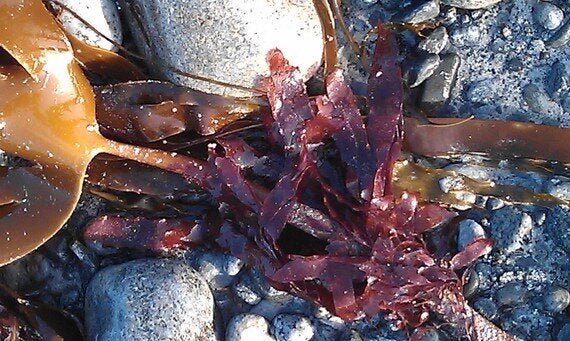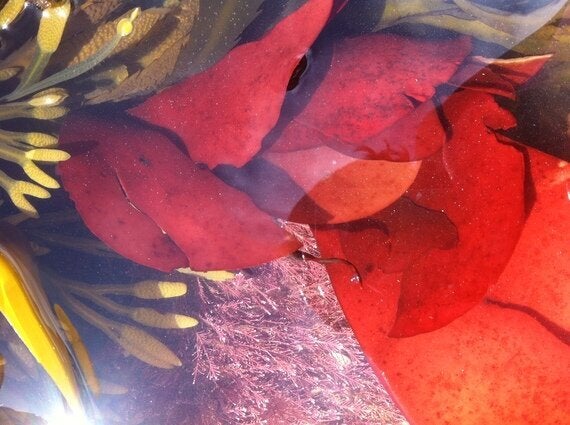
Dulse Palmaria palmata growing on Kelp
To date Scientists haven't paid as much attention to the study of seaweeds as they have to terrestrial plants. There is much to learn from which seaweeds different animals eat as to how they grow. Seaweeds are divided by colour into three main groups: red, brown and green. Worldwide there about 10,000 in total of which 7,000 are red, 2,000 brown and 1,000 green. That's a lot of seaweed to learn about. There are about 650 identified species around our UK shores, although correct identification may require the help of an expert equipped with a magnifying glass. The good news about foraging seaweed is that unlike some species of fungi, it isn't poisonous.The Desmarestia spp is one to avoid because it contains sulphuiric acid in its cells, which it releases when picked. You may like to pick it to preserve and mount on a card - it is pretty but not to eat. Don't store it in a bag with other seaweeds because it will rot them. The bad seaweed news ends here. Identify the Desmarestia spp from a decent guide or one of Mike Guiry's websites and the coast is clear.
British Seaweed is now for sale on the High Street. Mara Seaweed is available in Marks and Spencer and fresh and dried seaweed from The Cornish Seaweed Company is available in Tesco. Sea spaghetti or thong weed is as this company says in their press release, the seaweed most reminiscent of a store cupboard ingredient. Those who like to build seaweed bridges might cook it 50:50 with wheat spaghetti. My foraged sea spaghetti cooks in about 20-25 minutes. Blanched and refreshed it's a useful salad ingredient. I mix dried and ground sea spaghetti with Hebridean sea salt and I also use it in my seaweed sourdough starter. Once you consider seaweed beyond green and slimy and treat it as you would a vegetable, herb or spice, the culinary invention is endless. There is little didactic instruction available where seaweed is concerned, so even the timid cook has little to fear from the great of the food world.
Kelp is now being farmed in Ireland and sold ready to use. I note that they blanch the kelps, oar weed and sugar kelp and dabberlocks too, before it is frozen. This is useful information for the forager with a freezer. If you forage your own sea spaghetti blanch it before freezing. Dulse can be rinsed well, dried and flash frozen and then popped in a bag. It defrosts quickly.
Over the summer months landlocked folk who holiday by the sea, might check up on tide times and chase a low spring tide (when the sea retreats to expose rocks usually covered by water). Dulse is a delicious red seaweed to look out for. It grows on rocks but also as a non parasitic epiphyte on other seaweeds. It looks like a hand with fingers and varies in colour from red to ruby brown.

False Dulse Dilsea carnosa
False dulse is also available but that taste's OK too. Dulse remains malleable when dried, which is why historically, coastal folk chewed it. I think that it tastes of bacon. Cooked with potato (in the same cooking time) and mixed together, a dulse and potato rissole is a cheap, and tasty supper.The recipe is in Seaweed in the Kitchen published by Prospect Books next month.